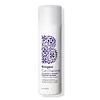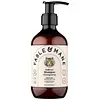What's inside
What's inside
 Key Ingredients
Key Ingredients

No key ingredients
 Benefits
Benefits

 Concerns
Concerns

 Ingredients Side-by-side
Ingredients Side-by-side

Water
Skin ConditioningLauramidopropyl Betaine
CleansingSodium Cocoyl Isethionate
CleansingGlycerin
HumectantGlycol Distearate
EmollientCocamidopropyl Hydroxysultaine
CleansingDisodium Laureth Sulfosuccinate
CleansingButyrospermum Parkii Butter
Skin ConditioningOryza Sativa Extract
AbsorbentRice Amino Acids
Skin ConditioningLactobacillus/Tomato Fruit Ferment Extract
Skin ConditioningPersea Gratissima Oil
Skin ConditioningRosa Canina Fruit Oil
EmollientAcanthus Mollis Leaf Extract
Skin ConditioningTocopheryl Acetate
AntioxidantAloe Barbadensis Leaf Juice
Skin ConditioningKeratin Amino Acids
Skin ConditioningCoconut Acid
CleansingHydrolyzed Quinoa
Skin ConditioningSodium Hyaluronate
HumectantAcyl Coenzyme A Desaturase
Skin ConditioningCitrus Aurantium Dulcis Peel Oil
MaskingCitrus Paradisi Peel Oil
MaskingPolyquaternium-71
HumectantSodium Lauryl Sulfoacetate
CleansingLeuconostoc/Radish Root Ferment Filtrate
AntimicrobialSodium Lauroyl Sarcosinate
CleansingSodium Isethionate
CleansingPolyquaternium-7
Anhydroxylitol
HumectantXylitylglucoside
HumectantXylitol
HumectantParfum
MaskingDehydroacetic Acid
PreservativeBenzyl Alcohol
PerfumingWater, Lauramidopropyl Betaine, Sodium Cocoyl Isethionate, Glycerin, Glycol Distearate, Cocamidopropyl Hydroxysultaine, Disodium Laureth Sulfosuccinate, Butyrospermum Parkii Butter, Oryza Sativa Extract, Rice Amino Acids, Lactobacillus/Tomato Fruit Ferment Extract, Persea Gratissima Oil, Rosa Canina Fruit Oil, Acanthus Mollis Leaf Extract, Tocopheryl Acetate, Aloe Barbadensis Leaf Juice, Keratin Amino Acids, Coconut Acid, Hydrolyzed Quinoa, Sodium Hyaluronate, Acyl Coenzyme A Desaturase, Citrus Aurantium Dulcis Peel Oil, Citrus Paradisi Peel Oil, Polyquaternium-71, Sodium Lauryl Sulfoacetate, Leuconostoc/Radish Root Ferment Filtrate, Sodium Lauroyl Sarcosinate, Sodium Isethionate, Polyquaternium-7, Anhydroxylitol, Xylitylglucoside, Xylitol, Parfum, Dehydroacetic Acid, Benzyl Alcohol
Water
Skin ConditioningSodium Cocoyl Isethionate
CleansingAloe Barbadensis Leaf Juice
Skin ConditioningCocamidopropyl Hydroxysultaine
CleansingParfum
MaskingDecyl Glucoside
CleansingLauryl Glucoside
CleansingSodium Lauroyl Sarcosinate
CleansingMaltitol
HumectantXylitol
HumectantXylitylglucoside
HumectantAnhydroxylitol
HumectantCocos Nucifera Oil
MaskingHelianthus Annuus Seed Oil
EmollientPueraria Lobata Root Extract
HumectantBacopa Monnieri Extract
Skin ConditioningEclipta Prostrata Extract
Skin ConditioningPelvetia Canaliculata Extract
Skin ProtectingAegle Marmelos Root Extract
Skin ConditioningCentella Asiatica Extract
CleansingDesmodium Gangeticum Root Extract
Skin ConditioningGmelina Arborea Root Extract
Skin ConditioningOroxylum Indicum Root Extract
Skin ConditioningPremna Serratifolia Root Extract
Skin ConditioningSolanum Indicum Root Extract
Skin ConditioningSolanum Xanthocarpum Root Extract
MaskingStereospermum Suaveolens Root Extract
Skin ConditioningTribulus Terrestris Root Extract
Skin ConditioningOrbignya Speciosa Kernel Oil
EmollientCurcuma Longa Root Extract
MaskingMelia Azadirachta Leaf Extract
Skin ConditioningPhyllanthus Emblica Fruit Extract
HumectantWithania Somnifera Root Extract
Skin ConditioningAstrocaryum Murumuru Seed Butter
EmollientLinum Usitatissimum Seed Oil
PerfumingHibiscus Sabdariffa Flower Extract
Skin ConditioningTrigonella Foenum-Graecum Seed Extract
PerfumingHydroxypropyl Guar Hydroxypropyltrimonium Chloride
Hydrolyzed Wheat Protein Pg-Propyl Silanetriol
Skin ConditioningEthylhexylglycerin
Skin ConditioningPolyquaternium-10
Polyquaternium-7
Glycerin
HumectantCoconut Acid
CleansingSodium Isethionate
CleansingSodium Lauroyl Lactylate
EmulsifyingCoco-Glucoside
CleansingDisodium Cocoyl Glutamate
CleansingGlyceryl Oleate
EmollientCitric Acid
BufferingPotassium Sorbate
PreservativePhenoxyethanol
PreservativeLeuconostoc/Radish Root Ferment Filtrate
AntimicrobialCoumarin
PerfumingWater, Sodium Cocoyl Isethionate, Aloe Barbadensis Leaf Juice, Cocamidopropyl Hydroxysultaine, Parfum, Decyl Glucoside, Lauryl Glucoside, Sodium Lauroyl Sarcosinate, Maltitol, Xylitol, Xylitylglucoside, Anhydroxylitol, Cocos Nucifera Oil, Helianthus Annuus Seed Oil, Pueraria Lobata Root Extract, Bacopa Monnieri Extract, Eclipta Prostrata Extract, Pelvetia Canaliculata Extract, Aegle Marmelos Root Extract, Centella Asiatica Extract, Desmodium Gangeticum Root Extract, Gmelina Arborea Root Extract, Oroxylum Indicum Root Extract, Premna Serratifolia Root Extract, Solanum Indicum Root Extract, Solanum Xanthocarpum Root Extract, Stereospermum Suaveolens Root Extract, Tribulus Terrestris Root Extract, Orbignya Speciosa Kernel Oil, Curcuma Longa Root Extract, Melia Azadirachta Leaf Extract, Phyllanthus Emblica Fruit Extract, Withania Somnifera Root Extract, Astrocaryum Murumuru Seed Butter, Linum Usitatissimum Seed Oil, Hibiscus Sabdariffa Flower Extract, Trigonella Foenum-Graecum Seed Extract, Hydroxypropyl Guar Hydroxypropyltrimonium Chloride, Hydrolyzed Wheat Protein Pg-Propyl Silanetriol, Ethylhexylglycerin, Polyquaternium-10, Polyquaternium-7, Glycerin, Coconut Acid, Sodium Isethionate, Sodium Lauroyl Lactylate, Coco-Glucoside, Disodium Cocoyl Glutamate, Glyceryl Oleate, Citric Acid, Potassium Sorbate, Phenoxyethanol, Leuconostoc/Radish Root Ferment Filtrate, Coumarin
 Reviews
Reviews

Ingredients Explained
These ingredients are found in both products.
Ingredients higher up in an ingredient list are typically present in a larger amount.
Aloe Barbadensis Leaf Juice comes from leaves of the aloe plant. Aloe Barbadensis Leaf Juice is best known for helping to soothe sunburns. It is also anti-inflammatory, moisturizing, antiseptic, and can help heal wounds.
Aloe is packed with good stuff including Vitamins A, C, and E. These vitamins are antioxidants, which help fight free-radicals and the damage they may cause. Free-radicals are molecules that may damage your skin cells, such as pollution.
Aloe Barbadensis Leaf Juice also contains sugars. These sugars come in the form of monosaccharides and polysaccharides, folic acid, and choline. These sugars are able to help bind moisture to skin.
It also contains minerals such as calcium, 12 anthraquinones, fatty acids, amino acids, and Vitamin B12.
Learn more about Aloe Barbadensis Leaf JuiceThis ingredient is created from dehydrating xylitol in acidic conditions. Xylitol is a famous sugar and humectant.
Much like its predecessor, anhydroxylitol is a humectant. Humectants attract and hold water to moisturize the skin.
This ingredient is most commonly found in a popular trio called Aquaxyl. Aquaxyl is made up of anhydroxylitol (24 - 34%), xylitylglucoside (35 - 50%), and xylitol (5 - 15%).
According to a manufacturer, Aquaxyl is known for a 3-D hydration concept and an anti-dehydration shield to reinforce the outer layer of skin.
This ingredient is often derived from plants such as wood and sugarcane.
Learn more about AnhydroxylitolCocamidopropyl Hydroxysultaine is a synthetic cleansing agent, though it is derived from coconut oil.
It is used to enhance the texture of products by boosting lather and thickening the texture. As a cleanser, Cocamidopropyl Hydroxysultaine is mild.
Coconut Acid isn't fungal acne safe.
Glycerin is already naturally found in your skin. It helps moisturize and protect your skin.
A study from 2016 found glycerin to be more effective as a humectant than AHAs and hyaluronic acid.
As a humectant, it helps the skin stay hydrated by pulling moisture to your skin. The low molecular weight of glycerin allows it to pull moisture into the deeper layers of your skin.
Hydrated skin improves your skin barrier; Your skin barrier helps protect against irritants and bacteria.
Glycerin has also been found to have antimicrobial and antiviral properties. Due to these properties, glycerin is often used in wound and burn treatments.
In cosmetics, glycerin is usually derived from plants such as soybean or palm. However, it can also be sourced from animals, such as tallow or animal fat.
This ingredient is organic, colorless, odorless, and non-toxic.
Glycerin is the name for this ingredient in American English. British English uses Glycerol/Glycerine.
Learn more about GlycerinLeuconostoc/Radish Root Ferment Filtrate is a natural preservative. It comes from fermenting radish roots with a bacteria called leuconostoc.
Leuconostoc comes from lactic acid.
This ingredient has antimicrobial properties and helps prevent the growth of bacteria in a product.
Leuconostoc is used to make the traditional Korean side-dish, kimchi. It is also used to make sourdough bread (both incredibly yummy foods).
Learn more about Leuconostoc/Radish Root Ferment FiltrateParfum is a catch-all term for an ingredient or more that is used to give a scent to products.
Also called "fragrance", this ingredient can be a blend of hundreds of chemicals or plant oils. This means every product with "fragrance" or "parfum" in the ingredients list is a different mixture.
For instance, Habanolide is a proprietary trade name for a specific aroma chemical. When used as a fragrance ingredient in cosmetics, most aroma chemicals fall under the broad labeling category of “FRAGRANCE” or “PARFUM” according to EU and US regulations.
The term 'parfum' or 'fragrance' is not regulated in many countries. In many cases, it is up to the brand to define this term.
For instance, many brands choose to label themselves as "fragrance-free" because they are not using synthetic fragrances. However, their products may still contain ingredients such as essential oils that are considered a fragrance by INCI standards.
One example is Calendula flower extract. Calendula is an essential oil that still imparts a scent or 'fragrance'.
Depending on the blend, the ingredients in the mixture can cause allergies and sensitivities on the skin. Some ingredients that are known EU allergens include linalool and citronellol.
Parfum can also be used to mask or cover an unpleasant scent.
The bottom line is: not all fragrances/parfum/ingredients are created equally. If you are worried about fragrances, we recommend taking a closer look at an ingredient. And of course, we always recommend speaking with a professional.
Learn more about ParfumPolyquaternium-7 is a light to clear colored liquid. It is commonly found in haircare products for its film-forming and anti-static properties.
According to a manufacturer, it is a non-paraben and specially developed for negatively charged surfactant systems. This makes it a great hairstyle holder and helps to improve wet hair detangling without adding buildup.
Sodium cocoyl isethionate is a natural ingredient from coconut oil. It is an ultra gentle cleanser that gives a nice foam without drying the skin or impacting the skin barrier.
The amount of foam created depends on the amount of sodium cocoyl isethionate used in the product.
This ingredient also helps improve the spreadability of a product.
Learn more about Sodium Cocoyl IsethionateWe don't have a description for Sodium Isethionate yet.
Sodium Lauroyl Sarcosinate is a cleansing agent and emulsifier. It is a surfactant derived from sarcosine, and a common source is coconut oil.
As a surfactant, Sodium Lauroyl Sarcosinate helps lift dirts, oil, and other molecules to be washed away. In leave-on products, this ingredient is used as an emulsifier. Emulsifier help prevent ingredients such as oils and waters from separating.
Sodium Lauroyl Sarcosinate is also commonly found as a foaming agent in shampoo, toothpaste, and shaving foam. It is amphiphilic, meaning it loves both water and fats.
Learn more about Sodium Lauroyl SarcosinateWater. It's the most common cosmetic ingredient of all. You'll usually see it at the top of ingredient lists, meaning that it makes up the largest part of the product.
So why is it so popular? Water most often acts as a solvent - this means that it helps dissolve other ingredients into the formulation.
You'll also recognize water as that liquid we all need to stay alive. If you see this, drink a glass of water. Stay hydrated!
Learn more about WaterXylitol is a humectant and prebiotic. It can help with dry skin.
In studies, xylitol has been shown to improve dry skin. It decreased transepidermal water loss, or when water passes through the skin and evaporates. Xylitol also showed to help improve the biomechanical properties of the skin barrier.
The prebiotic property of xylitol may also help reinforce our skin's natural microbiome. Having a healthy microbiome prevents infection by bad bacteria and helps with hydration.
As a humectant, Xylitol helps draw moisture from both the air and from deeper skin layers. This helps keep skin hydrated.
Xylitol is a sugar alcohol and commonly used as a sugar substitute. It is naturally occurring in plants such as strawberries and pumpkin.
Learn more about XylitolXylitylglucoside is created from xylitol and glucose, two humectants.
Not surprisingly, this ingredient is also a humectant. It attracts and holds water in your skin, helping to maintain hydration.
This ingredient is most commonly found in a popular trio called Aquaxyl. Aquaxyl is made up of anhydroxylitol(24 - 34%), xylitylglucoside (35 - 50%), and xylitol (5 - 15%).
According to a manufacturer, Aquaxyl is known for a 3-D hydration concept and an anti-dehydration shield to reinforce the outer layer of skin.
Learn more about Xylitylglucoside